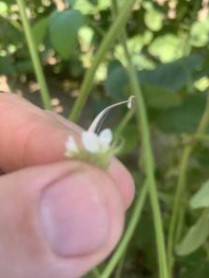By Brad Doyle
We had a very dry summer, and even with irrigation we were seeing drought stress in a few fields. While that weather gave us three great weeks of crossing soybeans, it was hard on other crops.
But in late August, a tropical storm brought between 5 and 10 cm, or 2 and 4 inches, of much-needed rain. And that storm was followed by other weather systems that created cloudy, wet conditions through the first week of September.
That rain has been good for our soybean fields, which we are growing to sell as seed next season. The rain will support pod fill, and support what we expect to be a high-quality crop with average yield. We have learned that planting date creates a trade-off at the end of the season. Planting earlier tends to produce higher yields. But planting later, as we did this year due to the weather, tends to produce higher quality soybeans because of the weather conditions during pod fill.
And, that rain means that we shouldn’t have to irrigate at least the early season varieties again this year. We monitor soybean development and make sure plants have the water they need until the soybeans inside the pods have grown enough that they are touching each other. This is when the soybeans have accumulated the maximum potential amount of dry matter. After that point, the soybeans begin to mature and dry out as they pull nutrients from the rest of the plant into the seeds. Some of our later-maturing soybean varieties may need more water, but that will depend on the weather.

To ensure soybean quality, we applied fungicides in mid-August. All these applications are made by airplane. We scout each of our fields to know what stage it is at and what protection it needs. Then we use university data from research funded by the soy checkoff to determine the best fungicide, rate and application timing for each field. Now that we have warm, wet weather, we are glad we treated with fungicide, as that should prevent diseases from damaging soybean quality.
We also scout for insects like podworms, which damage soybean pods and seeds, and stinkbugs, which suck fluids from developing soybeans inside the pods. We walk fields and use sweep nets to identify insect presence and need for treatment. So far, we have had to treat a few fields for podworms.
We expect be able to start harvesting our soybeans around September 20.
However, the rain that came with the tropical storm in late August interrupted our cross-breeding efforts. We hope to get several more days to finish making the crosses needed, and as I mentioned in my last article, crossbreeding works best in sunny weather, because the pollen sticks better. We only have until about the first week or so in September to make crosses before the plants will be past the appropriate stage.
Click here to see more...